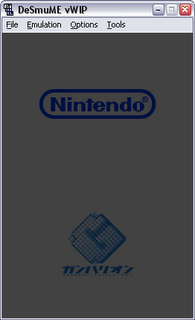Well, today I'll talk a bit about how the ds texture compression works and what I've accomplished with it (not that much, really). It's actually quite simply, if I understood it correctly (not sure I did). Well, a compressed texture is theorically, quite simple. We use one texture slot (even if not fully) for actual texture data, being it texture slot 0 or slot 2 (there're 4 possible slots in the DS).
For every 4x4 pixels block, we'll use one 32bit number from slot0 or slot2, that'll define the actual pixel data, 8bit a row per 4 columns, makes the total 32bit. So we define every pixel with a 2bit number, that'll use after for palette indexing. Now we need some more data, a 16bit value: the palette offset and a mode how this will be used, that'll will be located in texture slot1.
So, the general idea is quite simple in the end. Read a 32bit value from either slot0 or slot2, read a 16bit value from slot1. Then, use the 16bit value to determine the mode (there 4 possible modes, each filling each row in different manners) and palette index. With this palette index, go through each of the 2bit values, contained in the 32bit, and add each of them (separately, of course, for each colour) to the palette index, to get the final palette index to be used for each pixel. Then, with this value, you can just index in the normal palette data to get the colour. Depending on the mode, colours will be (or not) treated in different manners. Seems it's not that simple :P
My implementation is far from complete, I've severe bugs that just show lots of garbage. I'll try to fix it tomorrow.
I also have been doing some severe register hacking, that is just, that some memory locations are mapped to specific hardware of the DS. So, for example, writing to 4000490h will push a new 10b vertex to the render queue. So, I've just hacked a few of the registers so make games/demos work better, even if it's not correct emulation.
Just a simple screenshot today:
For every 4x4 pixels block, we'll use one 32bit number from slot0 or slot2, that'll define the actual pixel data, 8bit a row per 4 columns, makes the total 32bit. So we define every pixel with a 2bit number, that'll use after for palette indexing. Now we need some more data, a 16bit value: the palette offset and a mode how this will be used, that'll will be located in texture slot1.
So, the general idea is quite simple in the end. Read a 32bit value from either slot0 or slot2, read a 16bit value from slot1. Then, use the 16bit value to determine the mode (there 4 possible modes, each filling each row in different manners) and palette index. With this palette index, go through each of the 2bit values, contained in the 32bit, and add each of them (separately, of course, for each colour) to the palette index, to get the final palette index to be used for each pixel. Then, with this value, you can just index in the normal palette data to get the colour. Depending on the mode, colours will be (or not) treated in different manners. Seems it's not that simple :P
My implementation is far from complete, I've severe bugs that just show lots of garbage. I'll try to fix it tomorrow.
I also have been doing some severe register hacking, that is just, that some memory locations are mapped to specific hardware of the DS. So, for example, writing to 4000490h will push a new 10b vertex to the render queue. So, I've just hacked a few of the registers so make games/demos work better, even if it's not correct emulation.
Just a simple screenshot today:







